Ditapis dengan
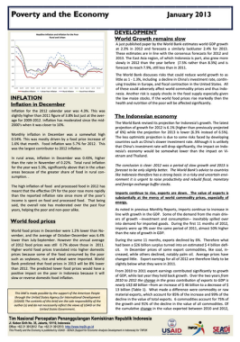
Poverty and the Economy January 2013
A just published paper by the World Bank esƟmates world GDP growth at 2.3% in 2012 and forecasts a similarly lackluster 2.4% for 2013. These estimates are in line with the consensus forecasts for 2012 and 2013. The East Asia region, of which Indonesia is part, also grew more slowly in 2012 than the year before (7.5% rather than 8.3%) and is forecast to reach 7.9%, sƟll less than in 2011.
- Edisi
- 1
- ISBN/ISSN
- -
- Deskripsi Fisik
- PDF, 2 Halaman
- Judul Seri
- Policy Brief
- No. Panggil
- 362.5 USA.P
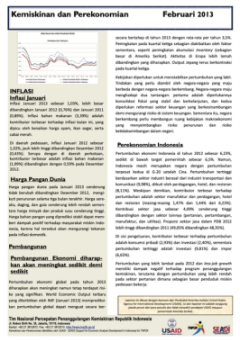
Kemiskinan dan Perekonomian Februari 2013
Secara bertahap di tahun 2013 dengan rata‐rata per tahun 3,5%. Peningkatan pada kuartal keƟga sebagian diakibatkan oleh faktor sementara, seperƟ peningkatan akumulasi inventory (sebagian besar di Amerika Serikat). AkƟvitas di Eropa lebih lemah dibandingkan yang diharapkan. Output Jepang terus berkontraksi pada kuartal ketiga
- Edisi
- 1
- ISBN/ISSN
- -
- Deskripsi Fisik
- PDF, 2 Halaman
- Judul Seri
- Policy Brief
- No. Panggil
- 362.5 USA.K
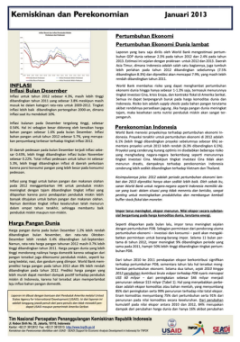
Kemiskinan dan Perekonomian Januari 2013
Indonesia’s economy grew by 6.23% in calendar year 2012, slightly below the government’s target of 6.5%. However, it was sƟll the second fastest‐growing country in the G‐20 aŌer China. The highest rate of growth were recorded in the transportaƟon and communicaƟon sector (9.98%), followed by the trade, hotel and restaurant sector (8.11%). However, the largest contributors to growth w…
- Edisi
- 1
- ISBN/ISSN
- -
- Deskripsi Fisik
- PDF, 2 Halaman
- Judul Seri
- Policy Brief
- No. Panggil
- 362.5 USA.K

Poverty and the Economy February 2013
Indonesia’s economy grew by 6.23% in calendar year 2012, slightly below the government’s target of 6.5%. However, it was sƟll the second fastest‐growing country in the G‐20 aŌer China. The highest rate of growth were recorded in the transportaƟon and communicaƟon sector (9.98%), followed by the trade, hotel and restaurant sector (8.11%). However, the largest contributors to growth w…
- Edisi
- 1
- ISBN/ISSN
- -
- Deskripsi Fisik
- PDF, 2 Halaman
- Judul Seri
- Policy Brief
- No. Panggil
- 362.5 USA.P
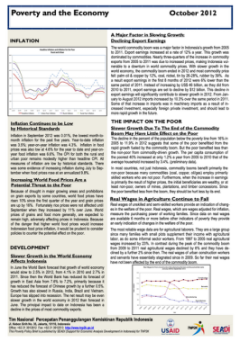
Poverty and the Economy October 2012
The world commodity boom was a major factor in Indonesia’s growth from 2005 to 2011. Export earnings increased at a rate of 12% a year. This growth was dominated by commodities. Nearly three-quarters of the increase in commodity exports from 2005 to 2011 was due to increased prices, making Indonesia vulnerable to a downturn in world commodity prices. With slower growth in the world economy, t…
- Edisi
- 1
- ISBN/ISSN
- -
- Deskripsi Fisik
- PDF, 2 Halaman
- Judul Seri
- Policy Brief
- No. Panggil
- 362.5 USA.P
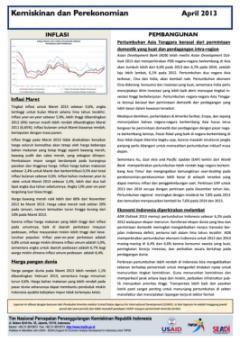
Kemiskinan dan Perekonomian April 2013
Tingkat inflasi untuk Maret 2013 sebesar 0,6%, angka tertinggi untuk bulan Maret selama lima tahun terakhir. Inflasi year-on-year sebesar 5,9%, lebih tinggi dibandingkan 2012 (4%) namun masih lebih rendah dibandingkan Maret 2011 (6,65%). Inflasi bulanan untuk Maret biasanya rendah, bertepatan dengan masa panen. Inflasi tinggi pada Maret 2013 tidak disebabkan kenaikan harga seluruh komoditas aka…
- Edisi
- 1
- ISBN/ISSN
- -
- Deskripsi Fisik
- PDF, 2 Halaman
- Judul Seri
- Policy Brief
- No. Panggil
- 362.5 USA.K
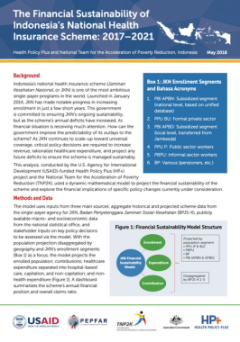
The Financial Sustainability of Indonesia’s National Health Insurance Schem…
Indonesia continues to make considerable progress to increase the membership of its social insurance program especially for its wage recipients (pekerja penerima upah/PU) who are mostly formal sectors workers. Unfortunately, coverage for the non-wage recipients/pekerja bukan penerima upah/BPU who mostly work at the informal sector workers are still very low (about 2.4 million active members as …
- Edisi
- 1
- ISBN/ISSN
- -
- Deskripsi Fisik
- PDF, 3 Halaman
- Judul Seri
- Policy Brief
- No. Panggil
- 368.4 TNP.T
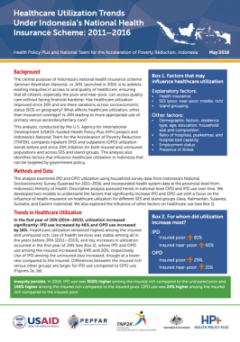
Healthcare Utilization Trends Under Indonesia’s National Health Insurance S…
The central purpose of Indonesia’s national health insurance scheme Jaminan Kesehatan Nasional, or JKN, launched in 2014, is to address existing inequities in access to and quality of healthcare, ensuring that all citizens, especially the poor and near-poor, can access quality care without facing financial hardship. Has healthcare utilization improved since JKN and are there variations across…
- Edisi
- 1
- ISBN/ISSN
- -
- Deskripsi Fisik
- PDF, 2 Halaman
- Judul Seri
- Policy Brief
- No. Panggil
- 368.3 TNP.H
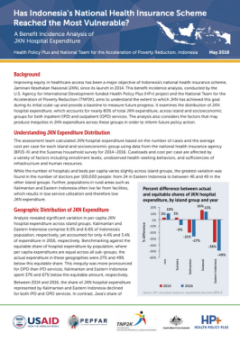
Has Indonesia’s National Health Insurance Scheme Reached the Most Vulnerabl…
Improving equity in healthcare access has been a major objective of Indonesia’s national health insurance scheme, Jaminan Kesehatan Nasional (JKN), since its launch in 2014. This benefit incidence analysis, conducted by the U.S. Agency for International Development-funded Health Policy Plus (HP+) project and the National Team for the Acceleration of Poverty Reduction (TNP2K), aims to under…
- Edisi
- 1
- ISBN/ISSN
- -
- Deskripsi Fisik
- PDF, 2 Halaman
- Judul Seri
- Policy Brief
- No. Panggil
- 363.8 TNP.H
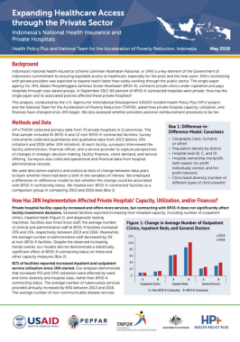
Expanding Healthcare Access through the Private Sector Indonesia’s Nation…
Indonesia’s national health insurance scheme (Jaminan Kesehatan Nasional, or JKN) is a key element of the Government of Indonesia’s commitment to ensuring equitable access to healthcare, especially for the poor and the near-poor. JKN’s contracting with private providers was expected to expand reach faster than solely working through the public sector. The single-payer agency for JKN, B…
- Edisi
- 1
- ISBN/ISSN
- -
- Deskripsi Fisik
- PDF, 2 Halaman
- Judul Seri
- Policy Brief
- No. Panggil
- 368 USA.E
 Karya Umum
Karya Umum  Filsafat
Filsafat  Agama
Agama  Ilmu-ilmu Sosial
Ilmu-ilmu Sosial  Bahasa
Bahasa  Ilmu-ilmu Murni
Ilmu-ilmu Murni  Ilmu-ilmu Terapan
Ilmu-ilmu Terapan  Kesenian, Hiburan, dan Olahraga
Kesenian, Hiburan, dan Olahraga  Kesusastraan
Kesusastraan  Geografi dan Sejarah
Geografi dan Sejarah